

During the Neolithic Age, people changed from being hunters and gatherers to being food producers. We call this transformation the Neolithic revolution.
This brief introduction to the Neolithic Revolution is a very general introduction of an enormous event in human development. The advent of agriculture opened up an infinite number of new possibilities for humankind. In fact, it is the first step of prehistoric man's long journey to what we now define as civilization. Of course, there are still centuries to go before our modern era, and this is only a single step, but nonetheless, it is a step in the right direction.
A revolution is often defined as a pivotal social, economic, cultural or governmental change. In the case of the Neolithic Revolution, however, it is, as you will see, all of these. An altered geography leads to the possibility of agriculture which in turn elicits the appearance of permanent settlements. For society to progress, the people must not only organize themselves but also discover new technologies.
Now that you have a basic understanding of what the Neolithic Revolution is about, it is time to begin examining your specific portion of it.

- Gather data from a variety of provided secondary documents. Taking notes is not necessarily required as you can refer back to the site.
- While reading, you will mentally analyze the information for relevance and importance (reliability is not a factor here).
On the banks of a small stream that winds though the hilly plains of central Turkey, the mysterious town of Catal Huyuk (chuh-TUL Ho-YOOK) was born about 8 000 years ago. Beneath the looming presence of three volcanoes, Catal Huyuk prospered for more than 2 000 years. Then it was abandoned about 5 600 BC, for some still unknown reason. The winds of passing ages tried hard to bury any trace of this once busy community, where as many as 6 000 people may have lived. However, in 1961, archaeologists discovered the well-preserved remains of this prehistoric town.
The people of Catal Huyuk left behind tools, beautiful wall paintings, and other objects that paint a vivid picture of how they lived. These neolithic people were hunters. They also farmed, growing wheat and barley, and they raised goats and sheep. With sharp flint tools to skin and cut, they made sandals from the leather, and they wove garments.
Curiously, the tightly packed, sun-dried brick houses of this neolithic metropolis had no doors. To enter, residents climbed down wooden ladders through a hole in the roof. Such a method of entry may have helped to keep out wild animals.
Each roof, made of woven reeds and mud, was connected on one or more sides to the houses next door. These roofs had to be strong enough to support the townspeople who walked across them to get from one house to another. On hot nights the roof even became a substitute bedroom.
Some members of the community found time create works of art, such as stone and clay figurines. Colorful murals, often showing hunting scenes, have been found on the walls of a number of unearthed buildings where religious rites may have been practiced.
Life for the people of Catal Huyuk was harsh, and it was short. By their late twenties, the people were nearing old age. At death, their bones were carefully wrapped and buried within their houses, where they remained through the centuries.
The change to a food-producing economy had enormous impact on the lives of humans. The advent of agriculture increased the food supply dramatically, making it possible for larger groups of people to live together in one area. Therefore, permanent communities or villages began to develop.
The earliest known village is Jericho, which archaeologists date back to 8 000 BCE. Another early village site was Catal Huyuk in southern Turkey, which prospered between 6 500 BCE and 5 700 BCE. Archaeologists have discovered that the Neolithic residents of Catal Huyuk lived in houses of sun-dried bricks with flat roofs made of mud-covered reeds. One of the unusual features of these homes was that they had no door. To help protect themselves against attack, residents entered their houses by ladder through a hole in the roof. Floors were covered with carpets of rushes and sleeping platforms were draped with mats.
...These activities gave rise to a new group of craftspeople or artisans such as potters, jewellers, metal workers, carpenters, and weavers. In turn , these artisans helped to promote the development of trade as they became interested in exchanging their wares for food supplies. Trade lead to new methods of transportation as Neolithic people began to think about better ways to transport their wares.
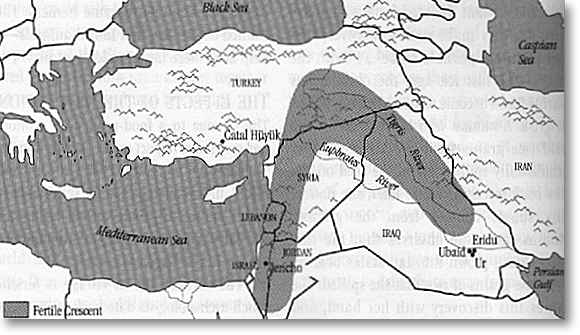
The "fertile crescent" in the Middle East,
containing the earliest known agricultural sites
The abundance of food and the ability to store it allowed another phenomenon: the growth of villages. No longer did people have to be spread thinly across a broad landscape in search of food. Food could be grown close to home, and animals kept nearby. A settled lifestyle made it worthwhile to construct permanent houses. The smallest settlements probably had only one or two houses, but larger sites with numerous houses had many more people.
The average Neolithic house was small, and probably home to a family consisting of mother, father, and children. One partially excavated site, Bouqras, on the Euphrates River in Syria, revealed dozens of houses. They varied in size from about 65 m2 to 139.5 m2, including a courtyard, presumably for cooking or animals. The houses were made of sun-dried clay bricks. The rooms often had white plaster floors, and the walls were plastered and perhaps painted.
Other important developments that originated during the Neolithic period include the ownership of property, manipulation of nature, and the celebration of human fertility.
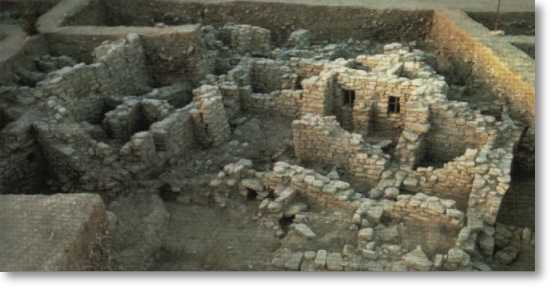
When people no longer depended on hunting for food,
it was not necessary to limit the number of children
to those who could walk or be carried. Thus, settling
and domestication of food sources allowed populations
to grow more quickly, and villages were formed. This
illustration is of the remains of a village in Jordan
(early Neolithic period). The stone houses show that
once people settled, building technology developed
rapidly, and quickly became sophisticated.
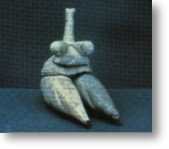
Many Neolithic clay figurines represent women with
large breasts and stylized heads. It is difficult
to know the precise meaning of such objects. With
a settled lifestyle, however, a lot of children was
not a drawback. Thus, the statuettes may have been
related to a new emphasis on human fertility.
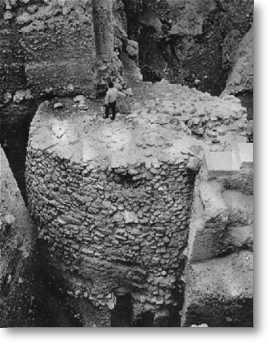
Neolithic villages varied in size. But even Jericho, a
large village by Neolithic standards, probably had less
than 1 000 people. Excavators at Jericho found a stone
tower, 10 m in diameter and still preserved over 8 m high.
Stairs inside led to the top. The tower abutted a stone
wall, and beyond was a large ditch cut into the bedrock.
Whether these structures were used for defense or to
control flooding, the planning and collective labor needed
to build them was remarkable.
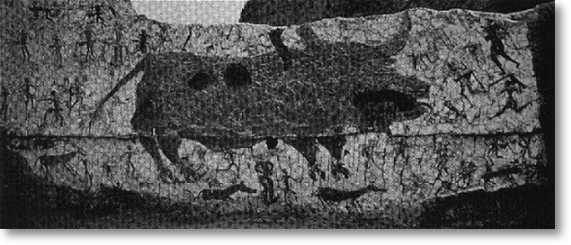
Catal Huyuk, in Turkey, is one of the largest and best
preserved sites of the Neolithic period. This pueblo-
like village contained many rooms, including shrines and
living areas. The walls were painted with scenes
including hunts and possibly ritual dances. Some walls
also had molded, painted relief figures of people,
leopards, stags, or bulls' heads. Many rooms had
platforms with human burials beneath.

Large storage containers, such as this one from Iran,
have been found in many Neolithic homes. [...] A
storage room such as this suggests the idea of private
property: food and seed are not stored in some central
location in the village, but in each house.
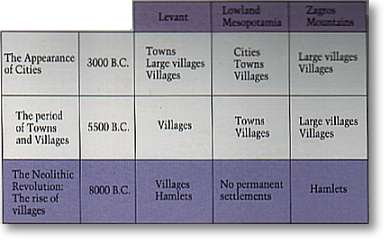
At the end of the Ice Age, small groups of people were
scattered over the land. Isolated villages developed
where there were abundant wild foods. By 8 000 BC, the
conventional starting point for the Neolithic period in
the Middle East, people had domesticated sheep, goats,
pigs, wheat, barley, and pulses. About 2 500 years
later, most villages had many or all of these foodstuffs.
Neolithic forms of organization and the domestication of
plants and animals occurred independently in most parts of
the world, but at different times.
Once the glaciers were gone, life became easier for people. Now they could count on a ready food supply. Often they grew more than they could eat in one winter. They could store food for the future. They would not have to move away from their homes to search for food. People began to live in settlements.
[...]
Within the Fertile Crescent was the town of Jericho. It is one of the earliest known towns. By about 8 000 BC Jericho was probably a farming village. Its people built rounded houses of mud and bricks. Archaeologists have found remains showing that the people of Jericho buried their dead right under their houses.
The land around Jericho was very fertile. The people grew many crops and became rich. The town grew. Jericho now had to protect itself. The people built a stone wall around their town.
But the wall was not enough. Around 7 000 BC archaeologists say Jericho was probably captured. The houses built after that time were no longer round, but had square corners. This clue suggests that a new group of people must have taken over and settled there.
Developments in Syria and Palestine in the eighth millennium BC were characterized by the appearance of many more farming sites, marking the transition to a fully agricultural economy.... [...] Large numbers of new sites appeared in the Judaean hills and in the loess area of the northern Negev, south of Beersheba. Further north, the central Levantine sites of Munhatta and Ramad belong to this phase, as do El Kowm and Bouqras on the Syrian steppe. These encompass a greater diversity of locations but sites suitable for floodwater farming, using seasonally high water levels, remain common.
[...]
These sites all round the Fertile Crescent and in southern Anatolia were linked by trade in small quantities of desirable raw materials such as obsidian (which was traded southwards from Anatolia down both the Levant and the Zagros) and even luxury materials such as turquoise, malachite and native copper.
Only about 10 million people existed at the beginning of the Neolithic Period.
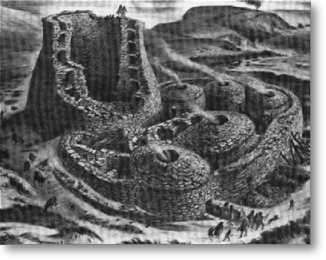
Neolithic villages were the ancestors of cities. An
artist's conception [...] shows how the Neolithic village
of Jarlshof in the Shetland Islands may have looked. A
wall surrounded the houses and a tall watchtower.

- Fill in the gaps using educated guesses (if there are any).
Having read and analyzed the provided data, you may have discovered some gaps that are not covered by the information. If so, you will need to make educated guesses to "fill in the blanks." When you are done or if you found none, continue on to the next step.

- Use the provided sources of information to construct your own viewpoint on the aspect of the Neolithic Period for which you are responsible. Using the word processor on your computer, you will then type up your interpretation of the data, in your own words, in a well-developed paragraph complete with a topic sentence. Co-operation with your partner is essential here.
The time has come for all your diligent research to pay off.
Note: Please follow the instructions as they are given. Read this paragraph before continuing on.
You and your partner will now discuss your interpretations of the data, agree on a single standpoint, and record it. Using a word processor on your computer, type up a well-developed paragraph presenting your viewpoint on your particular aspect of the Neolithic Revolution. This paragraph must have a topic sentence such as: "The Neolithic Revolution represents the origin of society and the foundation for later civilization." Try to be creative with your viewpoint; it is hoped that every group will interpret the evidence in a different way. The length of the paragraph will obviously vary but try to stay within the range of 200 - 400 words. One person doing all the typing is perfectly fine providing that there is input from both members. As previously mentioned, co-operation is essential. You will probably be referring back to this page when writing, but write the paragraph in your own words.
Read through then follow:
- Open the Start Menu and find your desired word processor (Microsoft Word, Claris Works, etc.). Note that it may be under "Programs."
- You and your partner agree on a standpoint about the evidence and type it up in the form of a well-developed paragraph with topic sentence, in your own words (referring back to this page when necessary--be sure to keep the browser window open).
- Proof read your paragraph for grammatical faults, spelling errors, etc.
- When you have a final copy done, and are still in the word processor, hit the following keys:
- Ctrl-A (to select everything) then
- Ctrl-C (to copy it to the Clipboard)
- Print off a copy of your paragraph for each member of your group, both for evaluation and study purposes (File > Print).
- After retrieving your sheet from the printer, save the file on the computer under your name (File > Save As...) then continue to the next step, "Submit and Review."
Note: If you have difficulty with any of these steps or are not sure you understand completely, please confirm with your teacher before proceeding. To those groups on Mac's: use the apple function key in the place of Ctrl.

- Submit your paragraph to your peers to be read. This is where the technology really comes into play: You will post your paragraph on a message forum where others can read it and comment if they wish. You can do the same with other groups' paragraphs.
You must now have a final copy of your paragraph and are ready to go to the message board to submit it and read those the other groups have prepared. If you have never used a message board before: don't panic. There is nothing to them. Detailed instructions are at the message board. You may now enter.